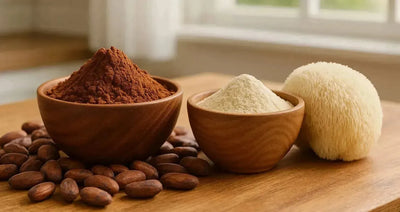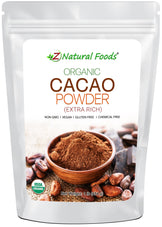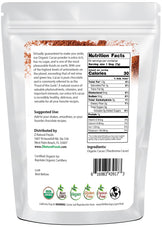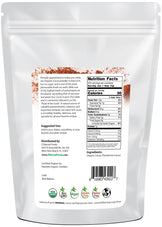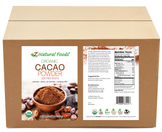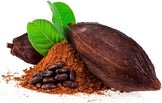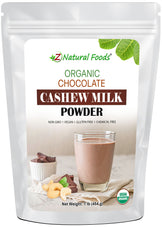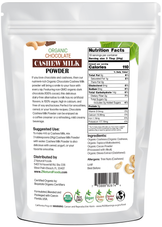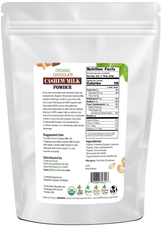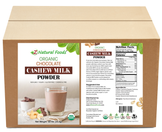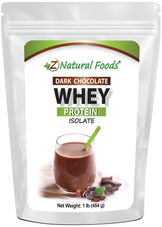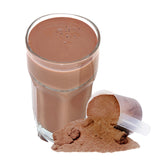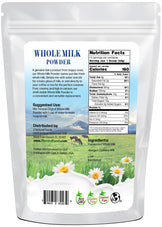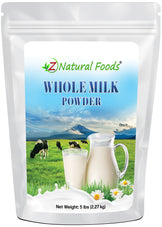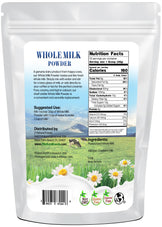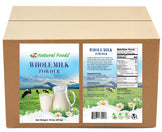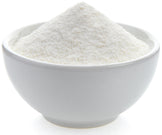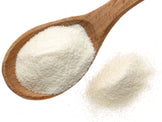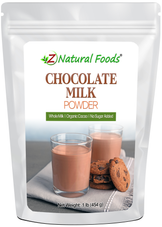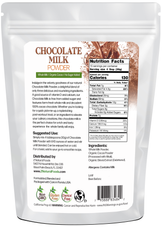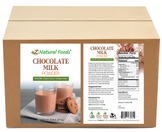Description
Description
Have you ever had the fantastic experience of eating pure, unadulterated cacao and savoring the rich, creamy, deliciously smooth texture and complex bitter flavor?
If not, you might make the mistake of many others by referring to real cacao as cocoa or chocolate.
Chocolate Milk Powder VS Cacao Powder: What is the Difference?
Most chocolate milk powders are a form of powdered milk mixed with a chocolate flavor. Cacao powder comes from cacao beans, and when it is mixed with additives it creates cocoa or chocolate. Z Natural Foods' Chocolate Milk Powder is a mix of pure whole milk powder with organic, raw cacao powder (no sugar added).
The terms cacao, cocoa, and chocolate are often interchangeably used, giving a false impression that they are all the same.
Would it surprise you to learn that only one food can be called cacao, and most of what you see on the market is just a sweeter indulgent variation created from this authentic food? In the end, they are all just imposters.
Here's Why You'll Want Pure Cacao - Not Cocoa nor Sugary-Chocolate, in Your Chocolate Milk Powder
In order to clearly define the difference between chocolate and cacao, it is vital to look at the multitude of different products created from cacao, like chocolate milk powder, and to understand their individual nourishing qualities.
So, let’s begin…
Pure cacao is one of nature's most wondrous creations and is seen as one of the most incredible foods on earth.
Cacao beans are the rawest, most pure, and unadulterated form of what you may know as chocolate. Untreated, raw, organic cacao has been used for centuries as a wonderfully nourishing food.
Cacao is exactly what Hippocrates had in mind when he said,
“Let food be thy medicine.”
Rich in the flavanols epicatechin and catechin, with procyanidins providing the majority of antioxidant activity. Cacao also contains a treasure trove of essential minerals like Calcium, Magnesium, and potassium.
Depending on the quality of your cacao and which food analysis you are looking at, one tablespoon of cacao (approximately 5 grams) yields 15 milligrams of calcium, 43 milligrams of magnesium, and 120 milligrams of potassium. Some ethnobotanists believe that cacao may be the most nutritious food you can put into your body.
The experience of eating a nourishing form of cacao can be attributed to the synergy of unique compounds in this food.
1. Caffeine: The great stimulant
Caffeine is the world's most widely used stimulating agent. It is well-known that caffeine stimulates the central nervous system. And according to studies, it may also stimulate blood flow in the brain and increase the secretion of serotonin. Around 300 milligrams (mg) a day of caffeine has been shown to be a beneficial dose for most adults. Approximately a 50-gram serving of cacao contains about 35 mg of caffeine.
2. Theobromine: The powerful antioxidant
Theobromine, or caffeine’s cousin, is primarily found in cacao and tea. In one 50-gram serving of cacao, you might discover about 250 mg of theobromine. Featured in Frontiers in Pharmacology, researchers found that this fantastic compound offers remarkable antioxidant properties, could be considered a safe and natural alternative in supporting specific health ailments, and is a lead compound for possibly developing novel future therapies.
3. Phenylethylamine (PEA): The feel-good chemical
Phenylethylamine (PEA) is the actual love compound found in cacao. While PEA is in cacao only in small amounts, it carries a significant effect. Via stimulation of the nervous system, PEA may trigger the release of endorphins and potentiate the activity of dopamine associated with sexual arousal and pleasure. So, in other words, that restless feeling you have when you are in love is primarily due to PEA.
Cacao is backed by human studies:
A Healthy Heart
Cacao may nourish many aspects of a healthy heart, and the research is quickly piling up. According to a Japanese study, the polyphenolic compounds (a class of antioxidants) found in cacao show great promise in possibly suppressing inflammation levels in the cardiovascular system.
Another study showed that consuming cacao flavanols may positively impact cardiometabolic function -- possibly affecting the heart and metabolic conditions like diabetes.
Nourish your brain with cacao:
Cacao may have even more happy effects. A study conducted by researchers at the University of Reading showed the positive effects of cacao on the pressure of blood flow to the brain, stating that “significant increases in regional perfusion across the brain were observed following consumption of the high-flavanol drink relative to the low flavanol drink, particularly in the anterior cingulate cortex and the central opercular cortex of the parietal lobe.” Therefore, it was concluded that these positive results from consuming cacao flavanols had provided evidence for possibly supporting cognitive performance.
Finally, a review of four studies discussing the effects of chocolate on cognitive function and mood concluded that two studies failed to demonstrate specific behavioral benefits but did show significant alterations to brain activation patterns. Two other studies did, however, report acute cognitive effects from consuming cacao polyphenols. Therefore, while it seems unclear whether the effects of chocolate on mood are due to the orosensory characteristics of chocolate or to the pharmacological actions of chocolate constituents, further exploration of the impact of chocolate on cognitive facilitation is recommended, along with substantiation of functional brain changes associated with the components of cacao.
Cacao Butter: A nourishing fat
Cacao contains approximately 50% fat, comprised of two saturated fatty acids (palmitic & stearic) and one mono-unsaturated fatty acid (oleic). In an article titled Cocoa and Chocolate in Human Health and Disease, the following facts are stated regarding the nourishing qualities of cacao fat.
- The oil in cacao, referred to as cocoa butter, is a mixture of monounsaturated and saturated fatty acids. In the monounsaturated fraction, oleic acid predominates, as it does in olive oil.
- The majority of saturated fatty acids in cacao are palmitic acid and stearic acid.
- Stearic acid is unusual because it does not elevate serum lipid levels to the same degree as other saturated fatty acids.
- Shorter-chain saturated fatty acids such as myristic acid (14:0) and palmitic acid (16:0) are associated with increased LDL and atherogenesis; stearic acid is not.
- Although the lipid content of chocolate is relatively high, one-third of the lipids in cocoa butter is stearic acid (18:0), which is believed to be non-atherogenic and to exert a neutral cholesterolemic response in humans.
These Two Important Factors Make the Best Chocolate Milk Powder
Not all chocolate milk powders are created equal:
When searching for a high-quality chocolate milk powder, there are two critical factors to consider.
- Using simple quality ingredients leads to a highly nourishing, great-tasting product, and
- Nothing extra added.
You may have noticed that many chocolate products show a wide variety regarding the percentage of cacao solids it contains. Cacao solids are the components of the cacao bean remaining after the fatty portion (aka butter) has been extracted. The amounts of cacao solids can range anywhere from 30%-100%. Like your morning cup of coffee, the purest form provides the most significant benefits.
The more sugar, artificial sweeteners, and refined ingredients you add, your body may have to work harder to derive the benefits.
When creating a functional food product, nothing is more important than having ingredients in a form that supplies a whole food complex.
- A whole food complex represents and delivers all nutrients and phytonutrients in their natural synergistic state.
- This assures the consumer will get quality nourishment in a form that is most adaptable to the body.
- Many chocolate milk products contain unnecessary extra ingredients, often because the primary components, milk and cacao (often not even pure cacao), used in those products are of such low quality.
- Pure, high-quality Cacao has a rich and bitter flavor profile, often an acquired flavor to the untrained pallet.
- But, only pure cacao provides you with the highest level of feel-good benefits falsely associated with chocolate products low in cacao solids.
Dutch and Alkalized Cacao: What Does it Mean?
You may have seen terms like Dutch or alkalized on a product label (you may know this as cocoa) and wonder what that means.
They are the same process in which the cacao has been washed in potassium carbonate alkaline solution. The process is done to reduce bitterness and PH levels and to neutralize the acidity, which completely changes the flavor profile of the end product.
Pure cacao has a pH of around 5-6 with a sharp, bitter flavor profile. Dutch-processed cocoa powder has a pH of 7 and a smooth, mellow, earthy flavor profile. Today, people's pallets are changing because they eat more dark chocolate and eventually become lovers of natural pure cacao. It is universally agreed upon that the Dutch/alkalized process severely degrades mood and brain-supportive qualities.
The common practice of using low-quality ingredients leads to adding additional contents into the product, like sugar and fortified nutrients, to support flavor and nutritional quality. Unfortunately, the end product becomes an overly processed, low-quality item providing no real nourishment.
In conclusion, consuming a pure 100% cacao product is best to get the maximal nourishing effects from cacao, just like what’s in our Chocolate Milk Powder.
This is not to say that those 70-85% cacao bars provide no nourishing qualities. These are what we call transitional foods, which are helpful to prepare your palate for the pure 100% benefits.
About our Chocolate Milk Powder
Z Natural Foods’ Chocolate Milk Powder has just 3 ingredients, featuring whole milk and 100% pure, organic cacao, with a splash of stevia for a touch of sweetness. With nothing else added, no artificial ingredients, and no added sugar, our Chocolate Milk Powder is not just one of the most pleasurable drinks on earth, it’s also one of the most nourishing.
For more information about cacao and all its delicious benefits, go here:
To review all of our Cacao products, go here:

